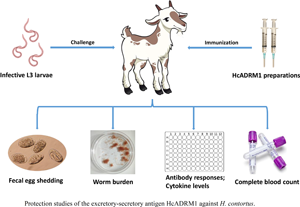Published online by Cambridge University Press: 30 June 2021

The prevention, treatment and control of Haemonchus contortus have been increasingly problematic due to its widespread occurrence and anthelmintic resistance. There are very few descriptions of recombinant antigens being protective for H. contortus, despite the success of various native antigen preparations, including Barbervax. We recently identified an H. contortus excretory–secretory antigen, H. contortus adhesion-regulating molecule 1 (HcADRM1), that served as an immunomodulator to impair host T-cell functions. Given the prophylactic potential of HcADRM1 protein as a vaccine candidate, we hereby assessed the efficacies of HcADRM1 preparations against H. contortus infection. Parasitological and immunological parameters were evaluated throughout all time points of the trials, including fecal egg counts (FEC), abomasal worm burdens, complete blood counts, cytokine production profiles and antibody responses. Active vaccination with recombinant HcADRM1 (rHcADRM1) protein induced protective immunity in inoculated goats, resulting in reductions of 48.9 and 58.6% in cumulative FEC and worm burdens. Simultaneously, passive administration of anti-HcADRM1 antibodies generated encouraging levels of protection with 46.7 and 56.2% reductions in cumulative FEC and worm burdens in challenged goats. In addition, HcADRM1 preparations-immunized goats showed significant differences in mucosal and serum antigen-specific immunoglobulin G (IgG) levels, total mucosal IgA levels, haemoglobin values and circulating interferon-γ, interleukin (IL)-4 and IL-17A production compared to control goats in both trials. The preliminary data of these laboratory trials validated the immunoprophylactic effects of rHcADRM1 protein. It can be pursued as a potential vaccine antigen to develop an effective recombinant subunit vaccine against H. contortus under field conditions.